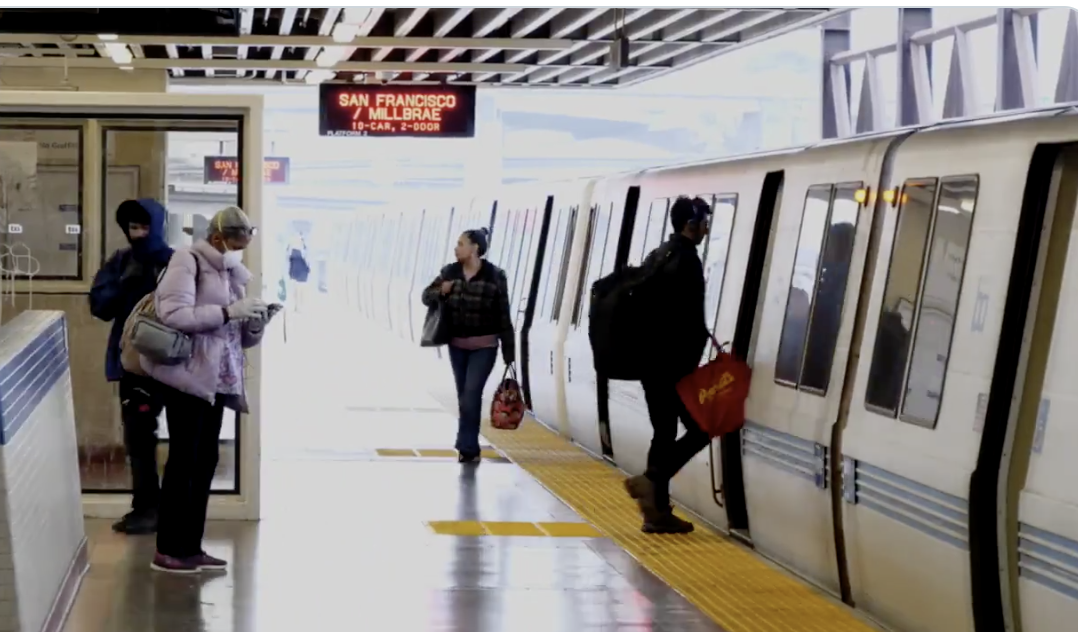
The COVID-19 pandemic has presented communications staff at transit agencies with a unique set of challenges. They’re tasked with letting the public know about constantly changing schedules and public health guidelines. They must reckon with uncomfortable facts, like plunging ridership, service cuts, and protective equipment shortages for operators. And they must also thread the needle between discouraging riders to board their system, and recognizing there are many people who must ride transit under difficult conditions.
Through clear, consistent, and transparent communication, San Francisco Bay Area Rapid Transit’s social media is managing to do all of these things well. BART’s communications have emerged as an invaluable resource for the media, riders, and elected leaders to learn about the crisis facing transit.
Sharing ridership information
Ridership on BART has been in freefall since the pandemic began. As of March 28, trips are down by 92% since the same date in 2019, largely due to San Francisco’s shelter-in-place order banning non-essential trips and the large number of Bay Area companies that have encouraged their employees to work from home. These ridership drops are proving financially catastrophic for BART, which receives 70% of its revenue through fares. If the shelter-in-place order continues through June, the agency expects fare revenue to be down 30%, or $140 million below budget for the fiscal year
While some agencies shy away from sharing bad news, BART’s social media team, led by comms veteran Alicia Trost, quickly made the decision to publicize ridership numbers every day. “We wanted people to know from the very first week when we started to see a 10% drop in ridership, that this was going to be a financial crisis.”
Ridership Data Update:
Ridership for Saturday was 18,793 representing a 87% drop compared to an average Saturday in Feb.
94,595 fewer riders rode BART yesterday compared to last Saturday before the shelter at home order was made. pic.twitter.com/44WWNkuAzl
— SFBART (@SFBART) March 22, 2020
Setting the expectation that BART would be providing daily ridership updates sent the message to reporters that the agency was a go-to source, and allowed BART to set the narrative. By consistently sharing the ridership numbers, “people really got to see the trend right away and saw how financially impactful it was going to be and it wasn’t us just crying wolf when they saw every single day it got worse and worse,” says Trost.
Continuing to serve essential trips
Like most agencies, BART has cut service as a result of COVID-19, shutting down the system from 9pm to 5am overnight and eliminating some peak-hour service. But while some transit agencies have explicitly discouraged people from riding at all, BART didn’t feel comfortable with communicating a “don’t ride, stay home,” message to its riders. “We know people face really difficult decisions every day. It’s so much more than just, ‘I’m not going to leave my house because someone told me not to leave my house.’” Instead, BART has chosen to welcome essential workers on its trains, highlighting the stories of people still riding in a short video.
The team has also worked hard to convey that riders can maintain safe physical distance on board, despite cuts to service. Using train arrival data mapped with the number of people tapping into a station, the team has been able to show that, on average, there were only four people per car on the peak hour trains that were eliminated, and there are now an average of 14 riders on the remaining peak hour trains. “The strategy was to show that if you have to ride BART for whatever reason it is, you can definitely maintain social distancing,” says Trost.
BART is running regular service during the shelter in place order to provide mobility for essential workers including first responders, health care providers, grocery store clerks, news media and more. We have long trains for social distancing.
Don’t ride if you are sick.— SFBART (@SFBART) March 17, 2020
Gaining Public Confidence
BART’s social media has been steadily building trust with its riders since the famous “this is our reality” tweetstorm in 2016, which alerted riders to the deteriorating state of the agency’s infrastructure and the enormous funding gap the agency was facing. Trost says this trust has proven especially useful in the current moment. “We see far less of, ‘You’re begging for money,’ because people know that educating riders about our finances is kind of the beat of our drum.”
Measuring Success
Trost has been pleased by the number of media outlets retweeting BART and reaching out for stories. “The Washington Post and Time Magazine and Rolling Stones all retweeted us this morning. And when the paper The Hill, called us, I was like, ‘Yes!’ Normally they’re only calling the New Yorks, the Chicagos…But now they’re calling BART.”
But most importantly, Trost is measuring success by the degree to which BART has been able to influence the conversation about the need for transit funding. “Senator Kamala Harris shared our video of the healthcare workers that we’re carrying right now. The Senate was working on the [stimulus funding bill] probably at the same time she shared it. It’s telling to us that they’re monitoring us. They are rooting for our riders and for our employees.”
 New TransitCenter Report: To Solve Workforce Challenges Once and For All, Transit Agencies Must Put People First
New TransitCenter Report: To Solve Workforce Challenges Once and For All, Transit Agencies Must Put People First
TransitCenter’s new report, “People First” examines the current challenges facing public sector human resources that limit hiring and retention, and outlines potential solutions to rethink this critical agency function.
Read More Built to Win: Riders Alliance Campaign Secures Funding for More Frequent Subway Service
Built to Win: Riders Alliance Campaign Secures Funding for More Frequent Subway Service
Thanks to Riders' Alliance successful #6MinuteService campaign, New York City subway riders will enjoy more frequent service on nights and weekends, starting this summer. In this post, we chronicle the group's winning strategies and tactics.
Read More